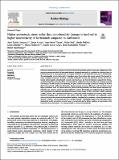Por favor, use este identificador para citar o enlazar a este item:
http://hdl.handle.net/10261/206090COMPARTIR / EXPORTAR:
 SHARE SHARE
 CORE
BASE CORE
BASE
|
|
| Visualizar otros formatos: MARC | Dublin Core | RDF | ORE | MODS | METS | DIDL | DATACITE | |

| Título: | Higher proteotoxic stress rather than mitochondrial damage is involved in higher neurotoxicity of bortezomib compared to carfilzomib |
Autor: | Jannuzzi, Ayse Tarbin; Arslan, Sema; Yilmaz, Ayse Mine; Sari, Gulce; Beklen, Hande; Méndez, Lucía CSIC ORCID; Fedorova, Maria; Arga, Kazim Yalcin; Yilmaz, Betul Karademir | Palabras clave: | Bortezomib Carfilzomib Mitotoxicity Neurotoxicity Peripheral neuropathy |
Fecha de publicación: | 2020 | Editor: | Elsevier | Citación: | Redox Biology 32: 101502 (2020) | Resumen: | Proteasome inhibitors have great success for their therapeutic potential against hematologic malignancies. First generation proteasome inhibitor bortezomib induced peripheral neuropathy is considered as a limiting factor in chemotherapy and its second-generation counterpart carfilzomib is associated with lower rates of neurotoxicity. The mitochondrial toxicity (mitotoxicity) hypothesis arises from studies with animal models of bortezomib induced peripheral neuropathy. However, molecular mechanisms are not fully elucidated and the role of mitotoxicity in bortezomib and carfilzomib induced neurotoxicity has not been investigated comparatively. Herein, we characterized the neurotoxic effects of bortezomib and carfilzomib at the molecular level in human neuronal cells using LC-MS/MS analysis, flow cytometry, RT-qPCR, confocal microscopy and western blotting. We showed that bortezomib and carfilzomib affected the human neuronal proteome differently, and bortezomib caused higher proteotoxic stress via protein oxidation, protein K48-ubiquitination, heat shock protein expression upregulation and reduction of mitochondria membrane potential. Bortezomib and carfilzomib did not affect the gene expression levels related to mitochondrial dynamics (optic atrophy 1; OPA1, mitofusin 1; MFN1, mitofusin 2; MFN2, fission 1; FIS1, dynamin-related protein 1; DRP1) and overall mitophagy rate whereas, PINK1/Parkin mediated mitophagy gene expressions were altered with both drugs. Bortezomib and carfilzomib caused downregulation of the contents of mitochondrial oxidative phosphorylation complexes, voltage-dependent anion channel 1 (VDAC1) and uncoupling protein 2 (UCP2) similarly. Our findings suggest that, both drugs induce mitotoxicity besides proteotoxic stress in human neuronal cells and the higher incidence of neurotoxicity with bortezomib than carfilzomib is not directly related to mitochondrial pathways | Descripción: | 12 pages, 6 figures, 1 table.-- This is an open access article under the CC BY-NC-ND license | Versión del editor: | https://doi.org/10.1016/j.redox.2020.101502 | URI: | http://hdl.handle.net/10261/206090 | DOI: | 10.1016/j.redox.2020.101502 | ISSN: | 2213-2317 |
| Aparece en las colecciones: | (IIM) Artículos |
Ficheros en este ítem:
| Fichero | Descripción | Tamaño | Formato | |
|---|---|---|---|---|
| Higher_proteotoxic_2020_OA.pdf | 2,51 MB | Adobe PDF |  Visualizar/Abrir |
CORE Recommender
PubMed Central
Citations
10
checked on 19-abr-2024
SCOPUSTM
Citations
14
checked on 19-abr-2024
WEB OF SCIENCETM
Citations
11
checked on 29-feb-2024
Page view(s)
147
checked on 23-abr-2024
Download(s)
169
checked on 23-abr-2024

